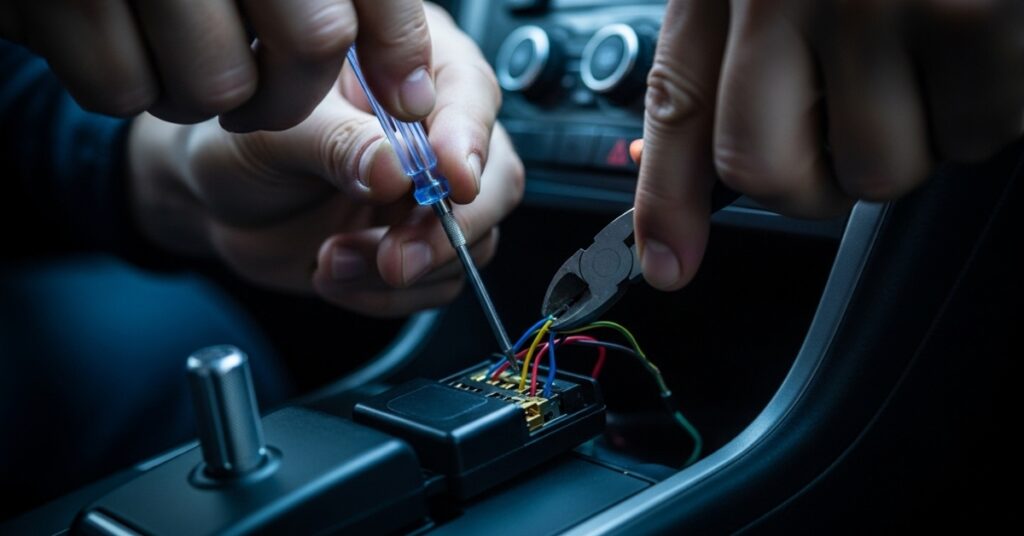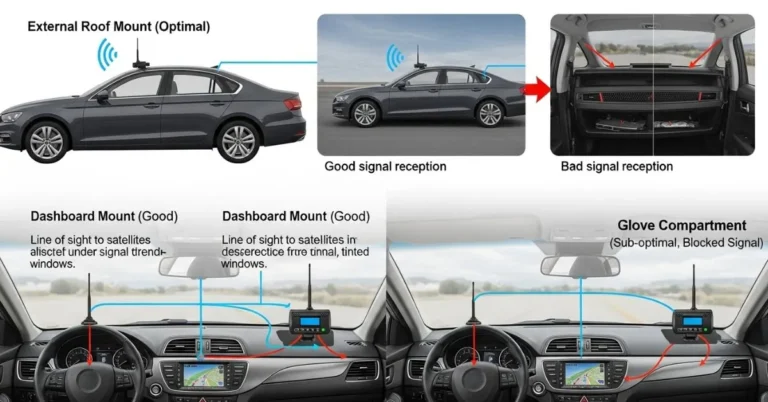Wondering how to disable GPS tracking device on car? It all started with a strange coincidence.

You were cruising down the highway, minding your business, when your phone buzzed with a suspicious message: “Nice drive today!” from someone you hadn’t spoken to in weeks. Or maybe it was when you popped by a friend’s house, and your ex “coincidentally” showed up at the same coffee shop minutes later. Red flags, much?
And now you’re seriously questioning your privacy.
Whether you’re a privacy-conscious driver, a used car buyer, or just someone who values independence, this guide dives deep into tracking tech, detection tactics, and expert steps to disable trackers correctly. You’ll leave knowing exactly how to protect your wheels and your personal freedom.
Contents
- 1 What Exactly Is a GPS Tracking Device?
- 1.1 Common Forms of GPS Trackers:
- 1.2 Is It Legal to Disable a GPS Tracker?
- 1.3 Step 1: Know the Telltale Signs of a Hidden Tracker
- 1.4 Step 2: Check the Most Common Tracker Hiding Spots
- 1.5 Step 3: Sweep the Car with an RF Signal Detector
- 1.6 Step 4: Remove OBD-II Port Trackers
- 1.7 Step 5: Deal with Hardwired GPS Devices
- 1.8 Step 6: Handle Tamper-Alert or Smart Trackers
- 1.9 Step 7: Consult a Professional Installer
- 1.10 Step 8: Stay Protected After Disabling the Tracker
- 1.11 Budget Tracker-Disabling Toolkit
- 1.12 FAQs: Disabling GPS Tracking Devices
- 1.13 Expert Thoughts: Reclaim Your Privacy, One Car at a time
- 1.14 About the Author
What Exactly Is a GPS Tracking Device?
A GPS tracking device is a small piece of hardware that communicates with satellites to pinpoint your car’s location in real time or through logged data. These gadgets can be powered by the car battery, standalone with internal batteries, or plugged into diagnostic ports.
Common Forms of GPS Trackers:
- OBD-II Plug-In Devices: Plug directly into the vehicle’s onboard diagnostic system.
- Magnetic Trackers: Stick to metal parts underneath the car.
- Hardwired Units: Installed behind dashboards or within the engine bay.
- Battery-Powered Trackers: Portable and hidden anywhere inside the vehicle.
Tech Trend: In 2025, over 60% of used cars sold in the USA may contain dormant or active aftermarket GPS trackers.
Is It Legal to Disable a GPS Tracker?
If You Own the Car:
Yes, you’re within your rights to remove or turn off any tracking device. You own the hardware; your privacy is your call.
In Lease or Fleet Vehicles:
Disabling a tracker in these may violate company policy or leasing agreements. Always read the fine print.
Disclaimer:
This blog serves as a resource for educational insight and general information only. Never tamper with a GPS tracker on a vehicle you don’t own or have explicit permission to alter.
Step 1: Know the Telltale Signs of a Hidden Tracker
Before you reach for a wrench or RF scanner, consider these warning signs:
- Sudden battery drain (tracking devices pull constant power).
- Unusual clicking or whirring sounds in the cabin.
- Unexpected messages or calls referencing your location.
- Bluetooth or radio interference near your vehicle.
- Your gut feeling – you know your car better than anyone.
If any of the above rings true, it’s time to investigate further.
Step 2: Check the Most Common Tracker Hiding Spots
External Areas to Inspect:
- Under the wheel wells
- Behind the bumpers
- Beneath the undercarriage/frame
- On the rear axle or suspension system
Internal Hideouts:
- Glove box compartments
- Under or behind the seats
- Inside center consoles
- Trunk or spare tire cavity
- Plugged into the OBD-II port (below the steering wheel)
Helpful Hack: Use a flashlight, mirror-on-a-stick, and a telescoping magnet to spot magnetic or battery-powered units.
Step 3: Sweep the Car with an RF Signal Detector
RF (Radio Frequency) Detectors are your best friend here. They help locate any device transmitting data via GSM, GPS, or Bluetooth.
How It Works:
- Turn off your car and any nearby devices.
- Power on the detector and sweep slowly.
- Listen for beeps or watch for signal spikes.
Affordable Options Include:
- Basic RF Bug Detectors
- Signal Sweep Kits with LED Alerts
- USB-Rechargeable Multi-Band Scanners
Affordability Tip: Most quality detectors cost between $35 and $60, which is way cheaper than hiring a private investigator.
Read More: How to Disconnect GPS Tracker Quickly: Tools, Tips & Tricks
Step 4: Remove OBD-II Port Trackers
These are the easiest to disable. They’re plug-and-play.
Steps:
- Turn off the vehicle.
- Locate the OBD-II port under the dashboard.
- Remove any suspicious devices plugged into it.
- Store the tracker in a Faraday bag to block signals.
Soft Suggestion: Contact your insurer if the tracker was installed for policy discounts. Removal might affect your premiums.
Step 5: Deal with Hardwired GPS Devices
Hardwired trackers are more complex and require care.
You’ll Need:
- Screwdriver or trim removal tools
- Wiring diagram for your car model
- Multimeter (optional, for electrical diagnostics)
How to Disable:
- Disconnect the car battery.
- Carefully remove panels near fuse boxes or behind the dashboard.
- Identify foreign wiring or unfamiliar modules.
- Gently disconnect, cap exposed wires, and reassemble panels.
Witty Tip: If it looks like a tiny black box with a red light and doesn’t belong, bingo.
Step 6: Handle Tamper-Alert or Smart Trackers
Some trackers are built to alert the owner when tampered with, while others ping the last known location before losing power.
How to Outsmart Them:
- Wrap the tracker in aluminum foil or drop it in a Faraday bag.
- Remove its battery (if visible).
- Avoid using brute force, which could damage car wiring or set off alerts.
Digital Security Angle: Disable Bluetooth on your phone while sweeping. Some trackers piggyback on smartphone signals.
Step 7: Consult a Professional Installer
If you’ve tried it all and still suspect your car is being tracked, it’s time to bring in reinforcements:
Who to Call:
- Mobile electronics specialists
- Car alarm installers
- Certified mechanics (especially for high-end or ex-fleet vehicles)
- Dealership technicians
Trend Note: Used cars from rental fleets or auctions often come with unremoved trackers ask for a complete electronic sweep before purchasing.
Step 8: Stay Protected After Disabling the Tracker
Now that you know how to disable GPS tracking device on car, don’t stop there. Protect yourself in the future:
Tips to Stay Off the Radar:
- Lock your OBD-II port with a port blocker.
- Scan your car monthly for new devices.
- Monitor unauthorized access with a dash cam.
- Keep electronics in signal-blocking pouches.
Privacy Power Move: Treat digital privacy like car insurance better to have and not need it.
Budget Tracker-Disabling Toolkit
| Tool | Use | Cost |
| RF Signal Detector | Find active signals | $35–60 |
| Inspection Mirror | View undercarriage | $10–20 |
| Faraday Bag | Block signal emissions | $15–25 |
| OBD Lock | Prevent reinstallation | $20–30 |
All-in Total: $100 or less for complete digital freedom.
Read More: How to Find a GPS Tracking Device on Your Car: Expert Tips
FAQs: Disabling GPS Tracking Devices
1. Can a GPS tracker work without the car running?
Yes. Battery-powered trackers can transmit data even when the car is off.
2. Is it illegal to remove a tracker?
Not if you own the car. For employer or leased vehicles, check your policy.
3. Will removing the tracker affect my insurance?
Suppose your insurer installed it for usage-based programs, yes. Contact them first.
Rare, but possible. Most devices won’t survive tire rotation or internal pressure.
5. Do GPS jammers work?
Some do, but they are illegal in many states. Use detectors and Faraday bags instead.
Expert Thoughts: Reclaim Your Privacy, One Car at a time
Disabling a GPS tracker isn’t just about electronics. It’s about reclaiming control, protecting your boundaries, and knowing where you go is your business and no one else’s.
In a world where tech is everywhere, it pays to stay a step ahead. Now you know how to disable GPS tracking device on car like a pro.
Stay sharp. Drive free.






